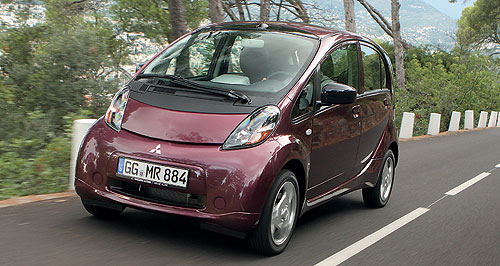Mitsubishi to launch i-MiEV at $50k
BY RON HAMMERTON | 9th Jun 2011

Mitsubishi Motors Australia Ltd (MMAL) admits it will not make a cent of profit on the cars that will be rationed to five a month through an initial network of just five specially equipped flagship Mitsubishi dealers – one in each mainland state capital.
But it says the i-MiEV will pave the way for eight electric and plug-in hybrid models it has in the pipeline – two of which can be expected to land in Australian showrooms in the next two years.
The first batch of 12 i-MiEVs, featuring European-model tweaks such as a bigger rear bumper and side privacy glass, are scheduled to lob in early August, beating its first serious rival, the Nissan Leaf, on to the market by about a year.
Australian pricing for the four-seat i-MiEV was meant to have been locked away at a Mitsubishi management meeting in Japan some days ago, but the head office discussion had to be postponed when one of the key executives could not make that meeting.

MMAL vice president of corporate strategy Paul Stevenson said the Australian subsidiary had not only bargained hard for sharp pricing on the i-MiEV, but was helped by the falling cost of the most expensive component – the lithium-ion battery pack – as production ramped up at battery factories established jointly by Mitsubishi and Yuasa Batteries in Japan.
He said future i-MiEVs were expected to be cheaper again – a fact that would be explained to early adopters, several of which already have their hand up for one of the early vehicles in Australia.
The company will offer a five-year warranty on the battery, even though it says the unit should retain 80 per cent efficiency after 10 years.
The production car has an official range of 155km, according to a new Australian Design Rule test, although Mitsubishi executives say real-world city driving is more likely to be about 100km.
With a governed top speed of 130km/h, the i-MiEV is powered by the same 16kW/hour battery pack and 49kW/180Nm electric motor driving the rear wheels as the 110 trial cars running around on Australian roads since last year.
However, features have been boosted with the addition of ESC, side and curtain airbags, a safety cut-off for the charging cable, auto headlights and a special keyless entry that switches off the silent-running electric powertrain when the car is unattended to prevent it running down the battery – a problem experienced in the trial phase when drivers forgot to hit the kill switch.
As well, the i-MiEV gets a crash safety system that cuts the high-voltage power on impact.
The three driving modes on the ‘transmission’ selector have been renamed, becoming D for drive, B for braking down hills – which boosts the regenerative capacity to recapture energy – and C for comfort (replacing Eco mode).
The i-MiEV, which already has been given a four-star safety rating by the Australian New Car Assessment Program (ANCAP), has gone straight to number one on the federal government’s green vehicle guide, with a 10-out-of-10 score on ratings for both greenhouse gas and air pollution emissions.
Mitsubishi says the cost of charging the i-MiEV’s batteries depends on the electricity tariff paid by the consumer, but even at an expensive 25-cent per kilowatt-hour ‘green electricity’ rate, the i-MiEV costs just $4 to ‘fill up’ for a 150km drive.
Recharging takes about seven hours from ‘empty’ on a 240-volt system, but less on fast chargers planned for some spots around the country.
Each owner will need to have a special 15-amp charging point installed in their garage or workplace, which Mitsubishi says cost only about $150, as long as a source of electricity is handy.
Mr Stevenson said the i-MiEV should be considered nothing more than a city car for urban commuting, and was never designed to drive interstate.
He said the trail-blazing i-MiEV might end up being viewed in future years in the same light as an early “brick” mobile phone or old laptop computer.
“The importance of the i-MiEV is not the car itself, but what it means to Mitsubishi’s future product range,” he said.
Mr Stevenson said the US Department of Energy had predicted battery costs would fall consistently over the next two decades, with the price of an automotive battery pack falling by two thirds between 2009 and 2015, when it was expected to be just $10,000.
Between 2020 and 2030, the price was expected to fall to about $3333.
At the same time, battery efficiency and weight would also improve, to the point where EV range could double to about 200km by 2015.
Mr Stevenson said the five dealers chosen for the six-month i-MiEV launch stage would have special training and equipment.
In 2012, all other Mitsubishi dealers would get the same benefits, allowing them to sell the i-MiEV and future EVs and plug-in hybrids if they wished.
Mr Stevenson said world-wide demand for stock was such that he did not expect a significant increase in i-MiEV volumes in 2012, but would hope to deliver more than 100 a year.
Mr Stevenson indicated that resale value might be an issue for early buyers, as the “value is going to be reflective of the price of new cars at that time”.
“Early adopters understand these things,” he said. “Someone who paid $15,000 for a plasma flat-screen TV when they first came out would have known they would become cheaper over time.”The 110 i-MiEVs currently being driven by ‘foundation customers’ – most large corporate and government fleets interested in EV performance – are all leased and will be returned to Mitsubishi after three years.
Although the nominal price was $63,000, the lessees will not end up paying that much.
If new customers want to lease an i-MiEV, they will have to make arrangements through a conventional lease company.
The i-MiEV will come in six colours: White, Black, Cool Silver, Ocean Blue, Raspberry Red and Titanium Grey.